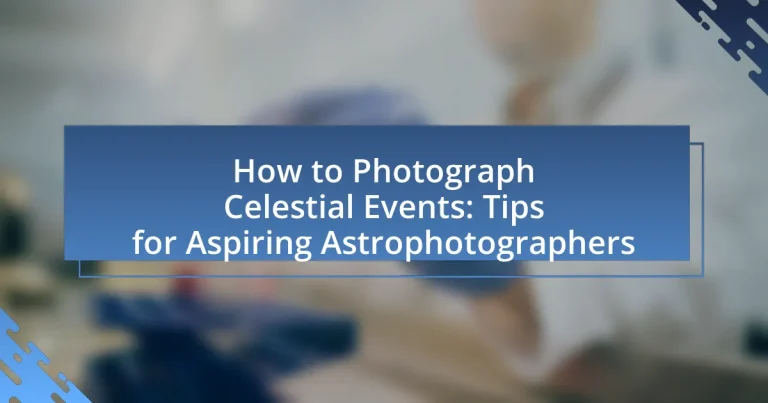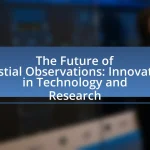The article focuses on the essential aspects of photographing celestial events, providing valuable insights for aspiring astrophotographers. It covers various types of celestial phenomena, including solar and lunar eclipses, meteor showers, and planetary alignments, detailing the unique techniques and equipment required for each. Key topics include the importance of astrophotography for scientific understanding, the necessary camera settings and equipment, and best practices for capturing and editing images of the night sky. Additionally, the article addresses common challenges faced in astrophotography and offers practical solutions to enhance image quality and clarity.
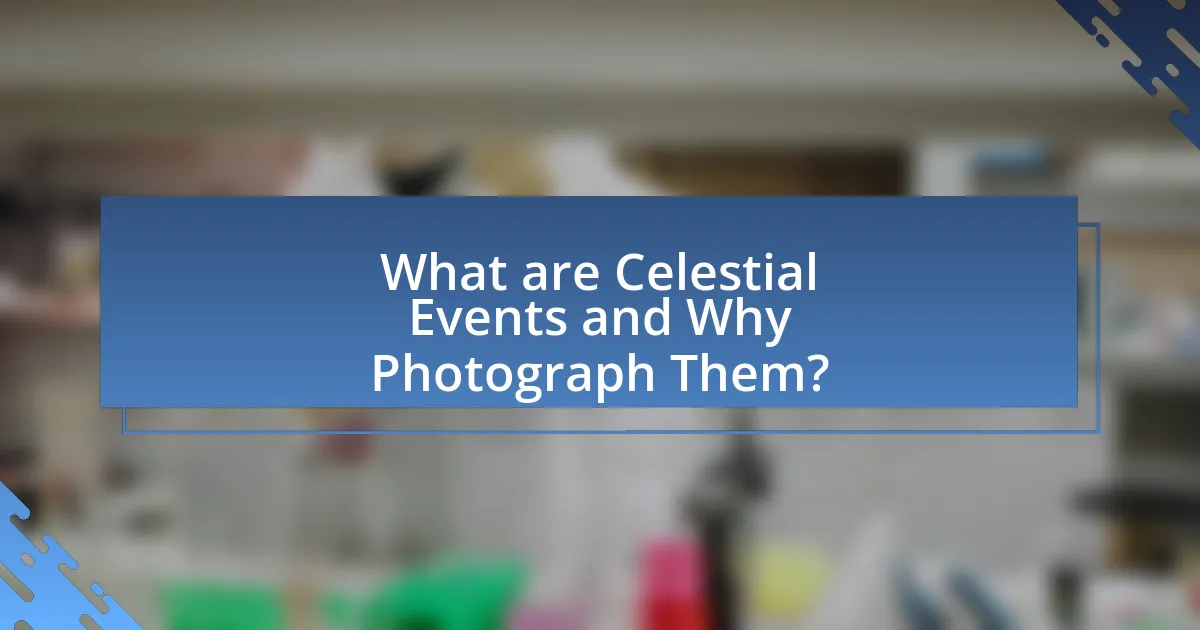
What are Celestial Events and Why Photograph Them?
Celestial events are astronomical occurrences that involve significant phenomena in the sky, such as eclipses, meteor showers, and planetary alignments. Photographing these events allows individuals to capture and document unique moments that can enhance scientific understanding and appreciation of the universe. For instance, the total solar eclipse of 2017 provided valuable data for researchers studying solar corona and atmospheric effects, while also offering stunning visual opportunities for photographers.
What types of celestial events can be photographed?
Celestial events that can be photographed include solar eclipses, lunar eclipses, meteor showers, planetary transits, and the Milky Way. Solar eclipses occur when the Moon passes between the Earth and the Sun, blocking sunlight, while lunar eclipses happen when the Earth casts a shadow on the Moon. Meteor showers, such as the Perseids or Geminids, are visible when Earth passes through debris left by comets. Planetary transits, like the transit of Venus, occur when a planet passes directly between the Earth and the Sun. The Milky Way can be captured during dark nights away from light pollution, showcasing our galaxy’s structure. Each of these events presents unique opportunities for astrophotography, allowing enthusiasts to capture stunning images of the universe.
How do lunar eclipses differ from solar eclipses in photography?
Lunar eclipses differ from solar eclipses in photography primarily due to their brightness and visibility. During a lunar eclipse, the moon reflects sunlight that passes through Earth’s atmosphere, resulting in a dimmer but more uniformly illuminated subject, making it easier to capture with standard camera settings. In contrast, solar eclipses involve photographing the sun, which requires specialized filters to prevent damage to the camera sensor and to capture the sun’s corona, as the brightness can overwhelm standard exposure settings. The need for different equipment and techniques is underscored by the fact that solar eclipses can only be viewed safely with protective gear, while lunar eclipses are safe to observe directly.
What are the best times to capture meteor showers?
The best times to capture meteor showers are during their peak activity, which typically occurs in the early morning hours before dawn. For example, the Perseids peak around August 12-13, while the Geminids peak around December 13-14. During these times, the sky is usually darker, and the number of visible meteors increases significantly, often exceeding 100 meteors per hour under optimal conditions. Observing from a location with minimal light pollution further enhances visibility, making these early morning hours ideal for capturing meteor showers effectively.
Why is astrophotography important for enthusiasts?
Astrophotography is important for enthusiasts because it allows them to capture and share the beauty of celestial events, fostering a deeper appreciation for the universe. This practice enhances their understanding of astronomical phenomena, as it requires knowledge of both photography techniques and celestial mechanics. Furthermore, engaging in astrophotography can build a sense of community among enthusiasts, as they often share their work and experiences through social media and forums, promoting collaboration and learning. The significance of astrophotography is underscored by the growing number of astrophotography competitions and exhibitions, which highlight the artistic and scientific value of this discipline.
How does astrophotography contribute to scientific understanding?
Astrophotography significantly contributes to scientific understanding by providing detailed visual data of celestial objects and phenomena. This visual data aids astronomers in analyzing the composition, structure, and behavior of stars, galaxies, and other astronomical entities. For instance, images captured through astrophotography can reveal the presence of exoplanets, the dynamics of supernovae, and the characteristics of distant galaxies, enhancing our knowledge of the universe. Furthermore, astrophotography has been instrumental in documenting transient events, such as meteor showers and eclipses, allowing for better predictions and understanding of these occurrences. The Hubble Space Telescope’s images, for example, have led to groundbreaking discoveries about the expansion of the universe and the existence of dark matter, showcasing the profound impact of astrophotography on modern astrophysics.
What personal benefits do photographers gain from capturing celestial events?
Photographers gain several personal benefits from capturing celestial events, including enhanced creativity, improved technical skills, and a deeper appreciation for the universe. Engaging in astrophotography allows photographers to experiment with composition and lighting, fostering artistic expression. Additionally, the technical challenges of capturing celestial phenomena, such as long exposure times and precise focus, help photographers refine their skills in camera operation and post-processing techniques. Furthermore, witnessing celestial events can instill a sense of wonder and connection to the cosmos, enriching their personal experience and perspective on life.
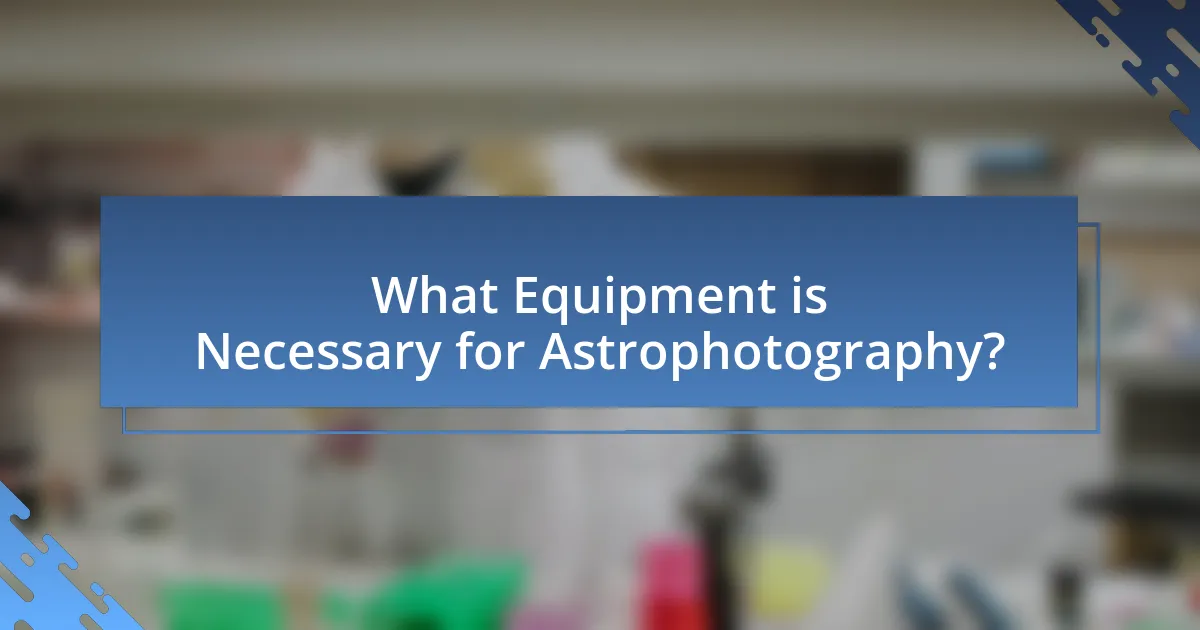
What Equipment is Necessary for Astrophotography?
To engage in astrophotography, essential equipment includes a DSLR or mirrorless camera, a sturdy tripod, and a telescope or telephoto lens. A DSLR or mirrorless camera allows for manual settings and long exposure times, which are crucial for capturing faint celestial objects. A sturdy tripod stabilizes the camera during long exposures, minimizing motion blur. Additionally, a telescope or telephoto lens provides the necessary magnification to capture detailed images of distant celestial bodies. These components are fundamental for achieving high-quality astrophotography results.
What types of cameras are best for photographing celestial events?
DSLR and mirrorless cameras are best for photographing celestial events due to their large sensors and interchangeable lenses. These cameras typically offer better low-light performance, allowing for clearer images of stars, planets, and other celestial phenomena. For instance, a full-frame DSLR can capture more light than a compact camera, resulting in improved detail and reduced noise in astrophotography. Additionally, cameras with manual settings enable photographers to adjust exposure times and ISO levels, which are crucial for capturing the faint light of celestial objects.
How do DSLR and mirrorless cameras compare for astrophotography?
DSLR and mirrorless cameras each have distinct advantages for astrophotography. DSLRs typically offer longer battery life and a wider selection of lenses, which can be beneficial for capturing celestial events. In contrast, mirrorless cameras are generally lighter, more compact, and provide better live view capabilities, allowing for easier composition and focusing in low-light conditions. Additionally, mirrorless systems often have superior autofocus performance in low light, which is crucial for tracking stars and celestial objects. These differences make mirrorless cameras increasingly popular among astrophotographers, as they can enhance the overall shooting experience and image quality.
What features should you look for in a camera for night sky photography?
For night sky photography, you should look for a camera with a large sensor, high ISO performance, and manual exposure controls. A large sensor, such as a full-frame or APS-C sensor, captures more light, which is crucial for low-light conditions. High ISO performance allows for clearer images with less noise when shooting in dark environments, enabling longer exposures without compromising image quality. Manual exposure controls provide the flexibility to adjust settings like shutter speed and aperture, essential for capturing stars and celestial events effectively. These features collectively enhance the ability to photograph the night sky with clarity and detail.
What lenses are ideal for capturing celestial phenomena?
Wide-angle lenses and telephoto lenses are ideal for capturing celestial phenomena. Wide-angle lenses, typically ranging from 14mm to 24mm, allow for expansive views of the night sky, making them perfect for photographing star trails, the Milky Way, and large celestial events like meteor showers. Telephoto lenses, generally between 200mm and 600mm, enable detailed close-ups of celestial objects such as the moon, planets, and distant galaxies. The combination of these lenses provides versatility in astrophotography, allowing photographers to capture both broad landscapes and intricate details of celestial bodies.
How does focal length affect the composition of celestial photographs?
Focal length significantly influences the composition of celestial photographs by determining the field of view and the level of detail captured. A longer focal length, such as 200mm or more, allows for tighter framing of celestial objects, making them appear larger and more detailed in the image. This is particularly beneficial for photographing distant objects like planets or nebulae, where capturing intricate details is essential. Conversely, a shorter focal length, such as 18mm to 50mm, provides a wider field of view, enabling the inclusion of more elements in the frame, such as the Milky Way or expansive star fields. This broader perspective can enhance the context of the celestial event within the landscape. Therefore, the choice of focal length directly affects both the scale of celestial subjects and the overall composition of the photograph, guiding the viewer’s focus and interpretation of the scene.
What are the advantages of using wide-angle lenses for astrophotography?
Wide-angle lenses offer several advantages for astrophotography, primarily their ability to capture expansive night skies and celestial events in a single frame. These lenses typically have a focal length of 24mm or less, allowing photographers to include more of the sky, which is essential for capturing phenomena like the Milky Way, meteor showers, and star trails. Additionally, wide-angle lenses provide a greater depth of field, enabling more stars and celestial objects to be in focus simultaneously. This characteristic is particularly beneficial when photographing landscapes alongside the night sky, as it enhances the overall composition. Furthermore, wide-angle lenses often exhibit minimal distortion, which helps maintain the integrity of celestial shapes and patterns in the image.
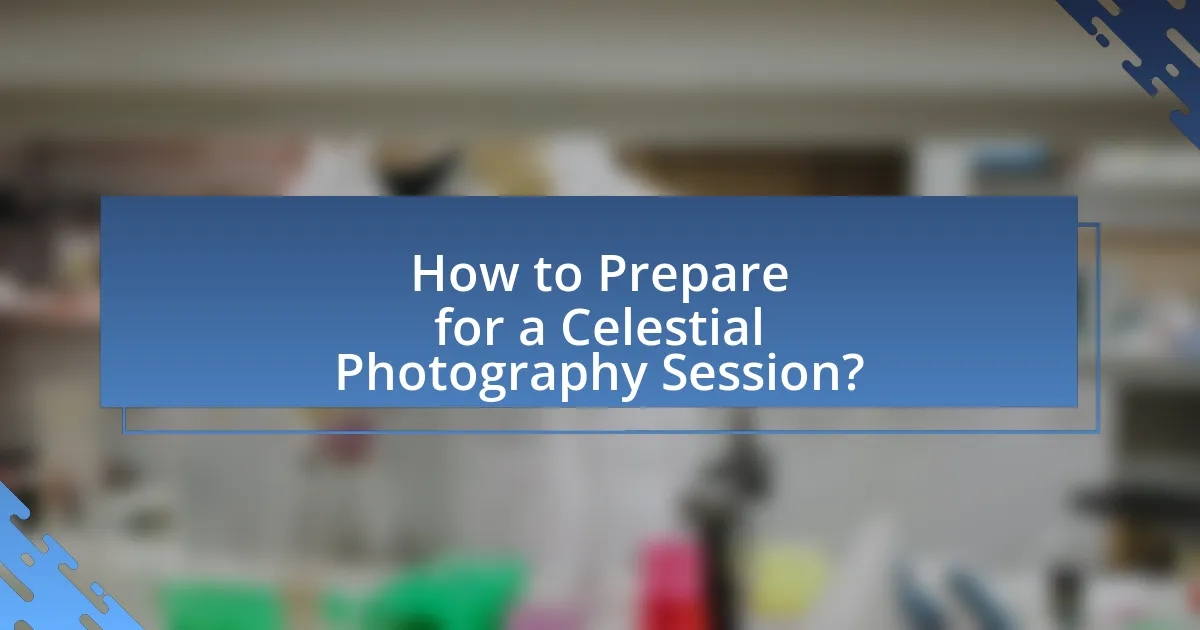
How to Prepare for a Celestial Photography Session?
To prepare for a celestial photography session, gather essential equipment such as a DSLR or mirrorless camera, a sturdy tripod, and a wide-angle lens with a low f-stop for optimal light capture. Additionally, familiarize yourself with the location and timing of celestial events, using apps like Stellarium or SkySafari to track stars, planets, and meteor showers. Check weather conditions to ensure clear skies, and plan to arrive at the shooting location early to set up and adjust your settings, including ISO, shutter speed, and aperture, for the best results.
What steps should you take to plan your astrophotography outing?
To plan your astrophotography outing, start by selecting a location with minimal light pollution, such as national parks or remote areas, to enhance the visibility of celestial objects. Next, check the weather forecast to ensure clear skies, as cloud cover can obstruct your view and affect image quality. Additionally, research the celestial events you wish to capture, including their timing and visibility, using resources like astronomy apps or websites. Prepare your equipment, ensuring your camera, lenses, tripod, and any necessary accessories are in good working condition. Finally, create a checklist of settings and compositions to optimize your shooting process during the outing.
How do you choose the right location for photographing celestial events?
To choose the right location for photographing celestial events, select a site with minimal light pollution, clear skies, and an unobstructed view of the horizon. Light pollution can significantly hinder visibility of celestial bodies; therefore, locations far from urban areas, such as national parks or remote countryside, are ideal. Clear skies are essential for capturing details, so checking weather forecasts for cloud cover is crucial. Additionally, an unobstructed view allows for better framing of celestial events, especially during phenomena like eclipses or meteor showers. Research indicates that locations at higher elevations often provide clearer atmospheric conditions, enhancing the quality of astrophotography.
What tools can help you determine the best time and conditions for shooting?
Astronomy apps and weather forecasting tools are essential for determining the best time and conditions for shooting celestial events. Astronomy apps like SkySafari and Stellarium provide real-time data on celestial events, including visibility times and locations of celestial bodies. Weather forecasting tools, such as Weather.com and AccuWeather, offer detailed forecasts on cloud cover, humidity, and atmospheric conditions, which are critical for planning successful astrophotography sessions. These tools enable photographers to optimize their shooting times based on both astronomical and meteorological data, ensuring the best possible conditions for capturing celestial phenomena.
How can you set up your equipment for optimal results?
To set up your equipment for optimal results in astrophotography, ensure your camera is mounted on a sturdy tripod and aligned with the celestial object you wish to capture. Use a wide-angle lens with a large aperture to gather more light, and set your camera to manual mode to control exposure settings effectively. A low ISO setting minimizes noise, while a longer exposure time captures more detail in dim light. Additionally, utilize a remote shutter release or timer to prevent camera shake during the shot. These practices are supported by astrophotography guidelines, which emphasize stability, light sensitivity, and exposure control for capturing clear images of celestial events.
What are the best camera settings for capturing stars and celestial bodies?
The best camera settings for capturing stars and celestial bodies include using a wide aperture (f/2.8 or wider), a high ISO setting (800 to 3200), and a long exposure time (15 to 30 seconds). These settings allow for maximum light capture, essential for revealing faint celestial objects. A wide aperture enables more light to hit the sensor, while a higher ISO increases sensitivity to light, and longer exposure times help to gather enough light without significant motion blur. This combination is widely recommended by astrophotographers and supported by practical experience in the field.
How do you stabilize your camera for long exposure shots?
To stabilize your camera for long exposure shots, use a sturdy tripod to minimize vibrations and movement. A tripod provides a stable platform that keeps the camera steady during extended exposure times, which is crucial for capturing sharp images of celestial events. Additionally, employing a remote shutter release or the camera’s self-timer can further reduce camera shake caused by pressing the shutter button. According to photography experts, using a tripod significantly enhances image quality by preventing blurriness, especially in low-light conditions typical of astrophotography.
What are some common challenges in astrophotography and how can you overcome them?
Common challenges in astrophotography include light pollution, equipment limitations, and atmospheric conditions. Light pollution can be mitigated by choosing dark sky locations or using light pollution filters. Equipment limitations can be addressed by investing in a sturdy tripod, a camera with good low-light performance, and appropriate lenses. Atmospheric conditions, such as turbulence and humidity, can be improved by planning shoots during stable weather and using software to stack images for better clarity.
How do light pollution and weather conditions affect your photography?
Light pollution and weather conditions significantly impact photography, particularly in astrophotography. Light pollution, caused by artificial lighting, reduces the visibility of celestial objects, making it challenging to capture clear images of stars and other astronomical phenomena. For instance, areas with high light pollution can diminish the contrast between celestial bodies and the night sky, leading to washed-out images. Weather conditions, such as cloud cover, humidity, and atmospheric turbulence, further complicate photography by obstructing visibility and affecting image clarity. For example, clouds can completely obscure celestial events, while high humidity can create haze that softens details in photographs. Therefore, both light pollution and weather conditions must be carefully considered to achieve optimal results in astrophotography.
What techniques can help you deal with noise in astrophotography images?
To deal with noise in astrophotography images, techniques such as long exposure noise reduction, stacking multiple images, and using noise reduction software are effective. Long exposure noise reduction involves taking a dark frame exposure of the same duration as the light exposure, which helps to subtract noise from the final image. Stacking multiple images increases the signal-to-noise ratio, as combining several exposures averages out random noise. Additionally, noise reduction software, like Adobe Lightroom or specialized astrophotography tools, can effectively reduce noise while preserving detail. These methods are widely used by astrophotographers to enhance image quality and clarity.
What are the best practices for editing astrophotography images?
The best practices for editing astrophotography images include using software like Adobe Photoshop or Lightroom to enhance details, adjust exposure, and reduce noise. Start by stacking multiple images to improve signal-to-noise ratio, which helps in revealing faint celestial objects. Next, apply adjustments to contrast and brightness to highlight features such as nebulae and star clusters. Additionally, utilize color correction techniques to ensure accurate representation of celestial colors, as many astrophotography images can appear overly saturated. Finally, sharpening the image selectively can enhance the clarity of stars and other details without introducing artifacts. These practices are supported by the common techniques used by astrophotographers to achieve high-quality results in their images.
How can software enhance the quality of your celestial photographs?
Software can enhance the quality of celestial photographs by providing tools for image processing, noise reduction, and detail enhancement. Programs like Adobe Photoshop and Lightroom allow astrophotographers to adjust exposure, contrast, and color balance, which can significantly improve the visual appeal of images. Additionally, specialized software such as DeepSkyStacker enables users to stack multiple images, effectively reducing noise and increasing detail visibility, resulting in clearer and more vibrant photographs. Studies have shown that image stacking can improve signal-to-noise ratios by up to 50%, making it a crucial technique for capturing high-quality celestial images.
What editing techniques are most effective for astrophotography?
The most effective editing techniques for astrophotography include stacking, noise reduction, and color correction. Stacking involves combining multiple images to enhance detail and reduce noise, which is crucial for capturing faint celestial objects. Noise reduction techniques, such as using software like Adobe Lightroom or specialized astrophotography tools, help eliminate unwanted graininess that can obscure details in the night sky. Color correction is essential for accurately representing the hues of stars and nebulae, often achieved through adjustments in saturation and white balance. These techniques are widely recognized in the astrophotography community for their ability to significantly improve image quality and clarity.
